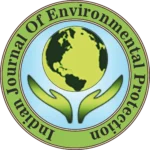IJEP 41(1): 72-78 : Vol. 41 Issue. 1 (January 2021)
C. R. Sahoo, T. K. Bastia and B. B. Kar*
Kalinga Institute of Industrial Technology (Deemed to be University), Department of Chemistry, School of Applied Sciences, Bhubaneswar – 751 024, Odisha, India
Abstract
The objective of this paper is to utilize waste coir pith, generated from coconut cultivation. During the study, the techno-mechanical properties of the particle board are being tested continuously. In this process, waste coir pith is dried and shredded into a size range within 1 cm. These shredded materials are then ground to smaller particle size in the range of 2-4 mm. The factors under consideration are density (900-1000 kg/m3). The experiments are carried out with variable temperatures in the range of 25-60°C. The boards after fabrication are tested for thickness, moisture content and water absorption. It has been found that all the panel boards are having a much higher density than that of the IS – 3087 standards except urea formaldehyde resin based boards. Similarly, thickness, moisture content, water absorption are within the range of standard IS – 3087. When they are subjected to mechanical parameters, properties such as tensile strength, compressive strength and flexural strength are taken into consideration. The data revealed that as compared to other panels, boards prepared using urea formaldehyde, phenol formaldehyde and melamine formaldehyde resin showed better tensile strength (that is 2 MPa) whereas boards made up of lignin formaldehyde and molasses formaldehyde are of lower tensile strength. Similar results are revealed in terms of compressive and flexural strength as well.
Keywords
Coir pith, Particle board, Urea formaldehyde resin, Lignin formaldehyde
References
- Veigel, S., et al. 2012. Particle board and oriented strand board prepared with nanocellulose-reinforced adhesive. J. Nanomaterials. DOI: 10.1155/2012/158503.
- Harshavardhan, A. and L. Muruganandam. 2017. Preparation and characteristic study of particle board from solid waste. IOP conference series: Mater. Sci. Eng., 263(3). DOI: 10.1088/1757-899X/263/3/032005.
- Gu, K., J. Hung and K. Li. 2013. Biobased adhesives, preparation and evaluation of particle board bonded with a soy flour-based adhesive with a new curing agent. J. Adhesion Sci. Tech., 18-19: 2053-2064.
- Raleigh, N.C. Review of particle board manufacture and processing. In Wood technology: Chemical aspects (chapter 13). Ed M.W. Kelly. pp 220–234.
- Moubarik, A., et al. 2010. Preparation and mechanical characterization of particle board made from maritime pine and glued with bio-adhesives based on corn starch and tannins. Technologia. 12(3): 189-197.
- Naudain, E. A. 1966. Method of preparing a wood particle board. US patent number US3287479A. Available at: https://patents.google.com/patent/US3287479A/en.
- Jin-shu, S., et al. 2006. Preparation and properties of waste tea leaves particle board. Forestry Studies in China.
- Farrissey, W. J., et al. 1969. Process for preparing particle board. US patent number US4374791A. Available at: https://patents.google.com/patent/US3440189A/en.
- Iwakiri, S., et al. 2014. Evaluation of the quality of particle board panels manufactured with wood from Sequoia sempervirens and Pinus taeda. CERNE. 20(2). DOI: 10.1590/01047760.2014 20021524.
- Kelly, M. W. 1977. Critical literature review of relationships between processing parameters and physical properties of particle board. General technical report. Forest Products Laboratory, Forest Service, U.S. Department of Agriculture.
- Suleiman, I.Y., et al. 2013. Development of eco-friendly particle board composites using rice husk particles and gum arabic. J. Mater. Sci. Eng. Adv. Tech., 7(1):75-91.
- Muruganandam, L., J. Ranjitha and A. Harshavardhan. 2016. A review report on physical and mechanical properties of particle boards from organic waste. Int. J. Chem. Tech. Res., 9(1): 64-72.
- Maldas, D. and B.V. Kokta. 1990. Studies on the preparation and properties of particle boards made from bagasse and PVC. I: Effects of operating conditions. J. Vinyl Additive Tech., 12(1): 13-19.
- Cui, J., et al. 2015. Enhancement of mechanical strength of particle board using environmentally friendly pine (Pinus pinaster L.) tannin adhesives with cellulose nanofibers. Annals Forest Sci., 72: 27–32.
